A Photographic Journey with the Legendary Canon EF 1200mm Lens
![]()
Someone, somewhere, recently decided to bid a fond farewell to one of the most legendary telephoto lenses ever made, the Canon EF 1200mm f/5.6 L USM. Now that it is at the B&H SuperStore, a group of photographers from B&H were given the opportunity to take this optical giant out for a unique shooting experience.
This lens is so rare that Canon does not even possess an example after the company’s one copy was damaged beyond repair in a shipping mishap. Oops. The B&H Used Department is welcoming its third Canon 1200mm lens. The last one to visit the SuperStore was sold in 2009.
When the assistant manager of the Web Content department comes to your desk and says that your presence is requested in the conference room, it usually means something cool is about to happen. I walked into a room full of people and was told — not asked — that I needed to take photos with this lens and write about the experience. Whoa. Cool! Let’s do this!
History
The Canon EF 1200mm f/5.6 L USM lens was born with the Canon FD mount and reportedly first appeared in 1984, at the Summer Olympic Games in Los Angeles, California. Five lenses were used by the media to cover the Games and then the lenses were shipped back to Japan and later converted to the EF mount. According to Canon, this is the longest lens in the world with full autofocus capability.
![]()
Canon made this lens available by special order only. A $10,000 deposit was required with the order and manufacturing would only start when several lenses were put on order. Sports Illustrated magazine purchased two 1200mm lenses in the 1990’s. Canon lent a lens to the St. Louis Post-Dispatch in 1999, so they could document Major League Baseball slugger Mark McGuire’s single-season home-run record attempt from center field; photographing every pitch McGuire faced that season. The extreme focal length of the lens gives a unique perspective of the distant view from the outfield fence that other lenses cannot capture.
Inside the metal barrel, two of the lens elements are constructed from enormous fluorite crystals that, according to lore, took more than a year to grow.
The lens is constructed of metal and painted in Canon’s signature white. Canon’s top professional lenses carry the “L” designation and a distinctive red band around the lens. The white paint applied to Canon’s large telephoto started as a practical application to enhance thermal stability for their largest lenses. As the flagship member of the esteemed “L Series,” the EF 1200mm easily features the largest red ring ever painted on a Canon lens.
The lens top has a substantial carry handle and the fixed tripod mount below is nearly identical to the handle in size and shape, giving the design symmetry and balance from top to bottom. A built-in lens hood telescopes to shade the front element from stray light, and a handsome, embroidered leather arrangement protects the front of the lens during transport. A standard Canon rear lens cap lives on the back.
It weighs just over 36 pounds. It is nearly 3′ long. The front opening is 9″ wide. The Canon EF 70-200mm f/2.8L IS II USM lens weighs 3.28 lb. Many “pro” lenses feature 77mm filters—the 77mm is a full 6″ smaller than the gaping circle at the front of this Canon. Speaking of filters, no one makes a 228.6mm circular polarizer, neutral density, or UV filter. The rear section of the lens has a drop-in gelatin holder for specially made 48mm filters.
![]()
If the 1200mm focal length is not long enough for you, the Canon Extender EF 1.4x II and 2.0x II teleconverters are happy to get you even closer. Put the EF 1200mm on a Canon APS-C format camera like the Canon 7D Mark II and you instantly have access to a 1920mm f/5.6 lens. Also, the Canon USA website lists 12mm and 25mm extension tubes as accessories for this lens to reduce the minimum focus distance to less than its native 45.9′.
A window atop the lens shows focal distance markings and has infrared indexing as well. In the world of lenses, this may be the only one that shows marked distances of 900 feet / 300 meters before you turn toward the infinity mark. How many focus rings do you see marked with triple-digit numbers, let alone numbers approaching four digits? At f/5.6, the hyperfocal distance of this lens is nearly 8 miles. Stop the lens down to f/32 and your hyperfocal distance is a comparatively small 1.4 miles.
Logistics
The vast majority of us, when planning to go out to take photos, spend our time considering what lenses we need to put into our bag, which ones we can leave behind to save weight, and what accessories we will need for a particular shoot. With the Canon 1200mm lens, planning involves not what to bring and leave behind, it starts with this question: “How many people do I need to bring with me to carry the gear needed to get the shot?”
If you own this lens, you had better have at least one friend who is passionate about photography and willing to carry heavy loads. You may be better off with two or more friends. Carrying the lens, camera bodies, and supports is more accurately a 2.5-person job. Hauling the gear to a location and shooting a lens like this is more akin to a logistics challenge than simple planning.
Also, there is nothing casual about this lens. You cannot just decide, on a whim, to take it outside to make some photographs. If you want to try to use the optic to its fullest potential, you will need to scout locations, have ideas of what images you want to capture, and keep an eye on the weather. Remember to do all this while coordinating the schedules of several other people who you will need to pull this off.
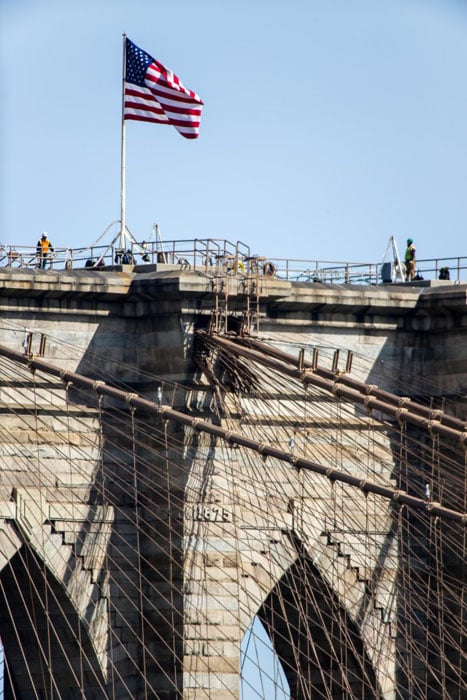
First Outing
The plan was to take the lens to the Brooklyn Bridge Promenade and then head to the DUMBO (Down Under the Manhattan Bridge Overpass) neighborhood. We figured the Promenade and DUMBO area would give us a variety of subjects to show off the unique capabilities of this lens since the view, from left to right, is Red Hook, Governor’s Island, the Statue of Liberty, Ellis Island, the southern tip of Manhattan including the Wall Street Heliport, One World Trade Center, South Street Seaport and other prominent buildings, the Brooklyn Bridge, and the Manhattan Bridge.
We brought the lens to the location shoot in the back of an SUV. Taking this lens down into the New York City subway would have been a difficult proposition, even without the rush-hour crowds. Carrying the case is a two-pallbearer operation. The empty case feels about the same weight as the lens. Put the lens in it, and you have an 80-lb load.
Safe setup requires a minimum of four hands, as well. Leave your travel tripod at home. You’ll want the biggest, heaviest support you can get to keep the Canon 1200mm lens steady. Also, because of the distance from the camera to the lens’s center of gravity, you are likely to find that a heavy-duty panning head with a long handle may make maneuvering the lens easier. We requisitioned a substantial video tripod from the Used Department for our mission, and it worked admirably. For action shots, a gimbal head would be the way to go.
Even with autofocus and the power of Canon’s latest flagship DSLR, the 1D X, shooting the 1200mm lens was challenging. The telephoto range is eye-popping; more than one shooter said, “Wow!” the first moment he looked through the 1D X viewfinder. Once you get over the initial shock of the lens’s reach, you start to settle in to make images.
With an extremely limited field of view, you find yourself looking through the proverbial soda straw. The narrow field of view brings the fact that you are shooting a fixed focal length prime lens to the forefront. Framing is what it is. You cannot zoom in or pull back and, if you want to take a few steps forward or backwards to change your frame, the size of this lens means that you need to get all hands on deck to pick up both the lens and support, or disconnect the lens from the tripod, move all the gear, and set up again. Extreme fixed focal length telephoto trumps flexibility.
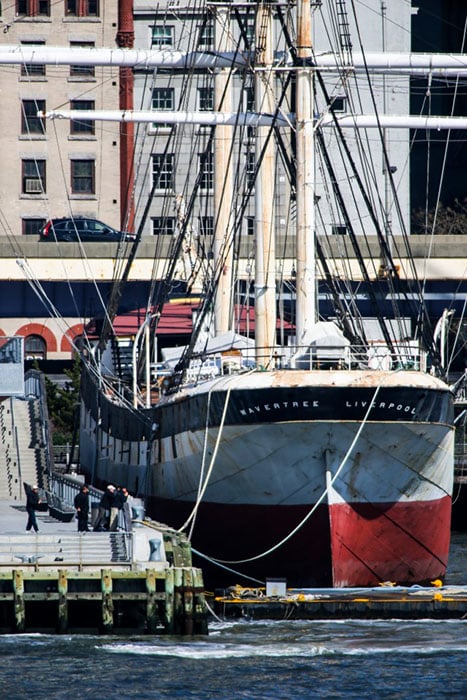
Speaking of moving it, in between locations, you can disconnect the lens from the tripod and throw the lens over your shoulder, but I wouldn’t plan on walking more than a few city blocks with it riding on your body like that. I carried the lens from the Promenade to the waiting SUV, maybe 100 yards. I could have gone farther, but was secretly glad a vehicle was waiting to take the load to the next location. The next day, I noticed a bruise on my right collar bone.
Before returning to the store, we shot the lens from the corner of 34th St and 9th Ave, in front of the B&H SuperStore. Pointing the lens at the Empire State Building, we were able to see individuals on the observation deck and details of the building’s design rarely seen from ground level.
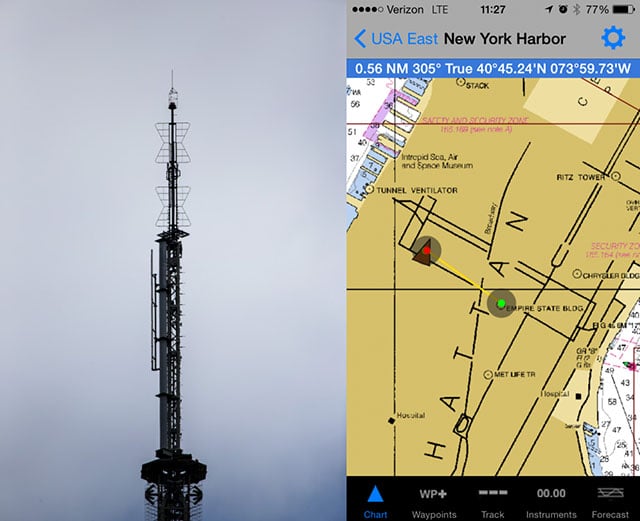
Second Outing
For the second outing with this lens, the B&H team chose to head to Staten Island, where we would have access to a variety of vantage points to try to illustrate the capabilities of the lens. Security stopped us in the ferry terminal. The bomb-sniffing dog was curious about the lens, but when I offered to open the case, the handler politely declined on behalf of the pup.
Arriving in Staten Island, we set up the lens at the ferry terminal and photographed the harbor, hoping to show the incomparable compression capabilities of a 1200mm lens. Shooting from the terminal illustrated one consideration that you must keep in mind when using this lens: air. It may be a crystal-clear day, free of haze, smoke, smog, and fog, but when you are taking photos of objects three miles away, the light reflecting from said objects has to travel through a lot of air to get through the lens. There is no doubt the Canon 1200mm is sharp and distortion free, but you cannot beat the physics that bends light traveling through everything that the air has to offer it over great distances.
![]()
![]()
Compression and Haze
Sailing on New York Harbor was a record-breaking trimaran, the Lending Club. The sailboat never made it very close to shore, but that was no issue for the Canon 1200mm. We were able to get images of the boat from a great distance that gave the perspective of shooting from the water on a chase boat in close proximity to the trimaran.
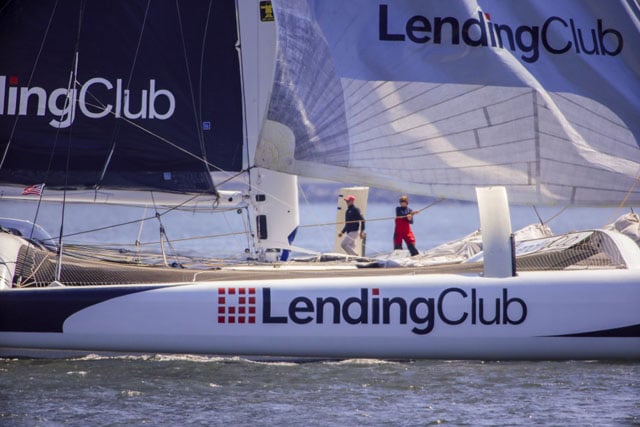
Unfortunately, foliage kept us from getting the towers of the Verrazano Bridge lined up, but we were able to do some detail work on the bridge.
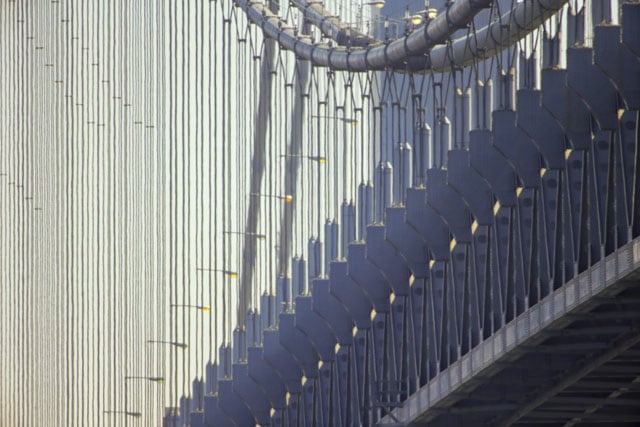
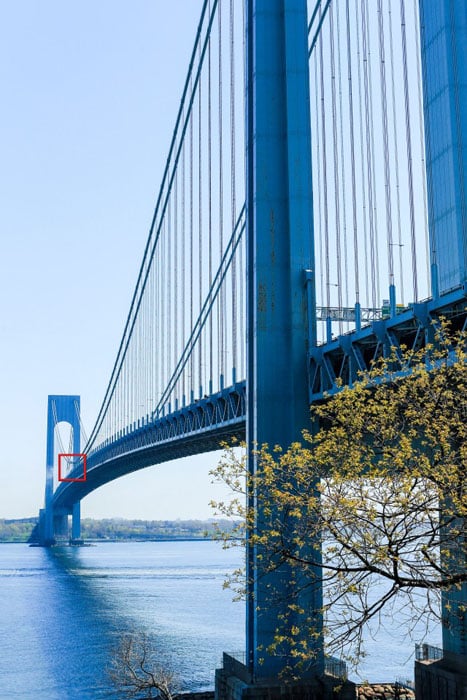
The Super Telephoto Experience
I find there are two things I enjoy when shooting long lenses. One, obviously, is bringing very distant objects closer to me. This is what telephotos do. With the Canon 1200mm lens perched on top of the Brooklyn Bridge Promenade, I was capturing images across the East River and New York Harbor that few other photographers will ever get to create. The lens gives you the ability to isolate subjects from afar where the only option for images captured with mere mortal lenses would be a significant crop of the image in post processing. It is all about the extreme reach of the lens. I can only imagine how using an APS-C format camera would extend this reach even farther.
From the comfort and quiet of the Promenade, I was able to photograph workers on top of the far tower of the Brooklyn Bridge and tell you what they were wearing, what color their hard hats were, and that the crews were wearing safety harnesses over their reflective work vests—from well over half-a-mile away.
But, the thing I most enjoy about the freedom of extreme telephoto is the opportunity it affords to create abstract images and focus on the parts versus the whole of whatever I am shooting. At 1200mm, this lens certainly provides a unique creative perspective and opportunity to create artistic images for a DSLR shooter. This is the draw of this lens for me.
![]()
I certainly would have liked to test this lens for birding, other wildlife, or sports, but my time with the massive lens was limited. One surprise was its ability to capture very good portraits. Traditional portrait focal lengths range between 75mm and 135mm. Let me be the first to say that a 1200mm lens is really good for portraiture.
The Canon’s incredibly shallow depth of field (1.1″ at f/5.6 and the minimum focus distance) ensured that the backgrounds were reduced to ultra-smooth renditions of unrecognizable creaminess. Even stopped down, the background objects never took form in the images from this lens. You may need walkie-talkies to communicate with and pose your subject, but, with a minimum focus distance of 46′, you are ensured of a very comfortable working distance between model and photographer!
Please note that even if the Canon 1D X had featured a fully articulating LCD screen, this camera/lens combination is completely unsuitable for selfies.
Crowds
As digital photography has taken over the art, and mobile phone photos are being snapped thousands of times a second, I have noticed that passersby, in general, do not dive out of the way of your path when you are taking photos out in public. Not long ago, no one wanted to cost you the expense of “wasting” a frame of film. People seemed to go out of their way not to interfere with a photograph. Today, everyone assumes you can just take another “free” shot with your digital camera and they often walk right through your composition.
However, when the Canon 1200mm was mounted on the tripod, New York pedestrians ducked and weaved out of the way as if the lens was about to fire a deadly projectile from its gaping aperture. It was amusing and extra noticeable in today’s world, where many fail to yield to photographers.
Wherever we set up, small crowds formed around us. Some asked questions. Some looked insecure with their small pocket-sized point-and-shoot cameras. If you own this lens, say goodbye to any feelings of lens envy.
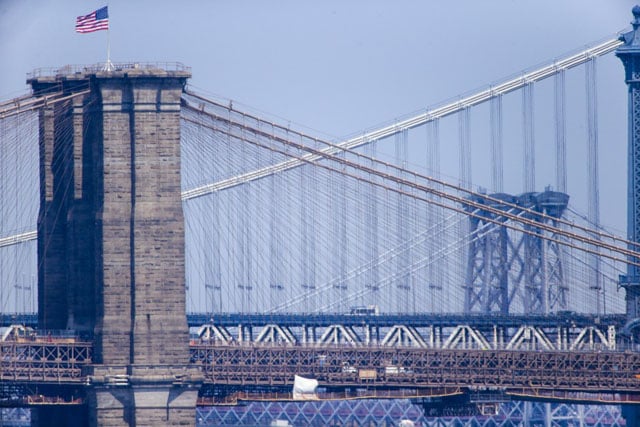
The lens was resting on a coworker’s shoulder to provide sufficient stability.
![]()
Third Outing
“The New York Times called. They want to do an article about the lens.” Put a unique used lens on the market, the Internet starts to buzz, and then a well-known local newspaper calls and asks if they can photograph with the lens and write a story about it.
So, the B&H team headed out to the Brooklyn Bridge Promenade once again to meet New York Times reporter James Barron and Metro Section photographer Chang Lee. Lee shot through the lens while Barron asked the B&H crew about the 1200mm. Based on what I observed, both the reporter and photographer were awestruck at the awesome power of the lens. As Chang was shooting the waterfront, a trio of US Marine Corps MV-22 Ospreys from squadron HMX-1 showed up, sporting their glossy green paint scheme. Perfect timing for some great shots with the Canon!
![]()
After packing up on the Promenade, the team headed to the Manhattan Bridge where Lee had the plan of shooting the Statue of Liberty through the Brooklyn Bridge at sunset. John Harris and I carried the lens about 1/3 of the way across the bridge for the shoot and, after getting half way there, I was wishing I had a hand truck in my back pocket. We reached the designated spot, arms lengthened by traction, and got ready to set up. Lee asked us to wait. I saw a lot of photos that could have been grabbed, but he knew what he wanted and had the patience to wait more than 45 minutes before getting the gear set up for his shot. It was interesting to see a modern-day working photographer display the kind of patience Lee did.
After sunset, we packed up in the dark and Harris and I hauled the Canon down the bridge to put it away for the night, saying goodbye to it for the last time…
…except, Shutterbug called the next day. They want to do a story, too.
Let B&H Buy Your Gear
As a thank you for letting me play with the amazing Canon 1200mm lens, I need to give B&H’s Used Department a plug. At press time, this lens is now for sale through the B&H Used Department. If you have gear to which you are ready to say goodbye, the B&H Used Department offers top dollar for everything, from legendary and rare lenses to your basic DSLR kit zooms. And, trading up or selling your gear to B&H is hassle free, with free shipping and quick payment back to you.
![]()
About the author: Todd Vorenkamp is a New York-based photographer and a writer for B&H explora. B&H explora is your one-stop destination for the latest news in gear, techniques, and tips and solutions for all your creative endeavors. Find features, videos, reviews, and buying guides about the products and technologies on which you depend to make your art and edit your media. B&H explora provides the information and inspiration that will help you excel at whatever you do. This article originally appeared on B&H Photo.